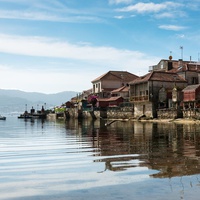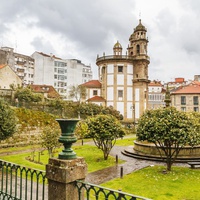Visiting Pontevedra and Combarro
Shore excursion from port of Vigo, Spain
- Duration 4h
- Activity level medium
What you'll do
Pick up at the port by our guide with a SHOREXC sign.
Departure from the port to Pontevedra. "Pontevedra dá de beber a quen pasa" is a Galician saying that expresses very well the essence of this city: hospitality. Parks, avenues, walks along the river in the middle of the city and a historic center that after Santiago, is the most important of Galicia. Stone architecture with emblazoned and inhabited houses, fountains, squares full of life and terraces with atmosphere until the early hours of the morning. We will visit this city that for about 20 years has been creating a city model that is exported to other places where the pedestrian is the priority. For this reason it has received several international awards being recognized, among other things, its high level of accessibility offering one of the most pleasant pedestrian visits. It is interesting to stroll through these labyrinthine but evocative streets, especially beautiful at night, which open continuously in cozy squares that in several cases maintain the name of its traditional mercantile vocation, as the Vegetable, where it still continues its sale, or the Firewood, very typical and popular character, with houses of good granite masonry, arcades, galleries and a cross in the center that make up one of the most famous postcards of the city.
We continue our way in search of the Plaza de A Ferrería, organized around a beautiful fountain of the XVI century, where we find a wide open space that includes the Praza da Estrela and the gardens of Casto San Pedro. This is the heart of the city, a place of passage, leisure and various celebrations.
We will visit the famous Sanctuary of the Pilgrim Virgin built from 1778, in the historic center of Pontevedra, in the Plaza de la Peregrina. It was declared a historic-artistic monument in 1982 and mixes late baroque with neoclassical forms, such as its main altarpiece, erected in 1789. It is one of the most symbolic and relevant buildings in the city and is dedicated to the Virgin who, according to tradition, guided the pilgrims from Baiona to Santiago. The image of the Pilgrim Virgin (19th century) is the patron saint of the province of Pontevedra and the Portuguese Way. It has a scallop-shaped plant, symbol of the pilgrims on the Camino de Santiago. We will approach the church of St. Mary, considered one of the jewels of Galician art, located on top of a mound, is built on a small Romanesque church dedicated to St. Mary, which was the first parish of Pontevedra. At the end of the 15th century, beginning of the 16th century, the old church was demolished and the construction of the new temple in late Gothic style began.
We will continue our visit to Combarro. Declared a Historic-Artistic Site, this small town combines the Galicia of the sea with that of the countryside, since in addition to having been a fishing port, it preserves interesting examples of traditional Galician architecture highlighting its 60 hórreos, the typical granaries of Galicia, of which 30 are lined up facing the sea. As characteristic and Galician as the hórreos are the stone and granite cruceiros that also abound in Combarro. It seems that they protected the crossroads where it was believed that meetings of meigas (witches) were held, making them safe places. The cruceiros of Combarro have the particularity that the figure of the virgin carved in them always looks towards the sea. In addition to cruceiros and hórreos, Combarro is famous for its mariñeira houses. We will be able to see some houses with the typical division that placed the house on the upper floor and the lower one destined to storage for fishing and agricultural implements.
After finishing our visit to Combarro we will return to the port to say goodbye.
Details
NO SUPPLEMENTS
REMARKS
- Level Easy/Panoramic/Cultural
- It is advisable to wear comfortable shoes.
- Important note: The center of Combarro has narrow streets, some of them sloping, which are very difficult to access for wheelchair users. People with reduced mobility who use wheelchairs must be accompanied by other people who can help them. Shorexc staff and the driver, by law, cannot assist these people because they do not have the necessary qualifications. Please use folding wheelchairs, as the buses do not have lifts or ramps. We are not responsible if the client does not inform us of their situation at the time of booking.



